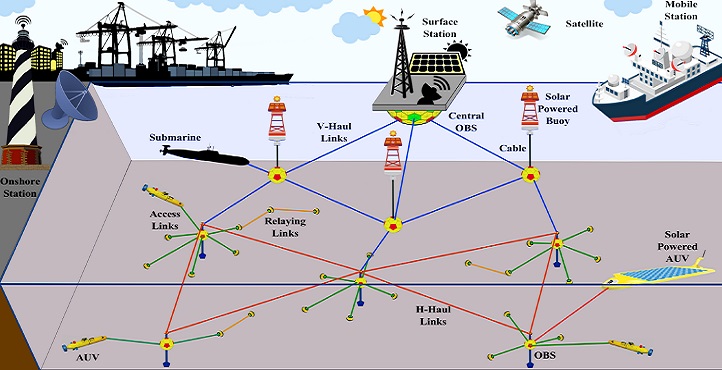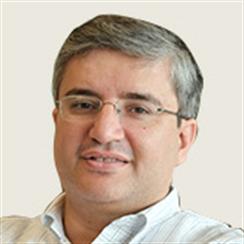Electrical Engineering
Marine exploration sensing with light and sound
Unveiling new strategies to improve future wireless underwater sensing networks for marine research and communication.


From left to right: Prof. Slim Alouini, Abdulkadir Celik, Nasir Saeed and Assoc. Prof. Tareq Al-Naffouri.
© 2018 KAUST
Oceanic sensor networks that collect and transmit high-quality, real-time data could transform our understanding of marine ecology, improve pollution and disaster management, and inform the multiple industries that draw on ocean resources. A KAUST research team is designing and optimizing underwater wireless sensor networks that could vastly improve existing ocean sensing equipment.
“Currently, underwater sensors use acoustic waves to communicate data,” explains Nasir Saeed, who is working on a new hybrid optical-acoustic sensor design with colleagues Abdulkadir Celik, Mohamed Slim Alouini and Tareq Al-Naffouri. “However, while acoustic communication works over long distances, it can only transmit limited amounts of data with long delays. Recent research has also shown that noise created by humans in the oceans adversely affects marine life. We need to develop alternative, energy-efficient sensors that limit noise pollution while generating high-quality data.”
One option is to use optical communication technology instead, but light waves will only travel short distances underwater before they are absorbed. Optical sensors also rely heavily on pointing and tracking mechanisms to ensure they are correctly orientated to send and receive signals. The team therefore propose a hybrid sensor capable of transmitting both acoustic and optical signals simultaneously. In this way, a data-collection buoy on the water surface can communicate with every sensor in a network spread out beneath it.
However, marine research requires accurate measurements taken from precise locations, so scientists need to know where every sensor is at any given time. The team used mathematical modeling to develop a proof-of-concept localization technique.
“Using our technique, the sensors transmit their received signal strength information (RSSI) to the surface buoy,” says Saeed. “For a large communication distance, the sensors use acoustic signals, but if the sensor is within close range of another sensor, it will send an optical signal instead.”
Multiple RSSI measurements for each sensor are collected by the surface buoy. The buoy then weights these measurements to give preference to the most accurate readings before calculating where each sensor is positioned.
Alouini’s and Al-Naffouri’s teams propose that their sensors will require a new energy source rather than relying on short-term battery power. They envisage an energy-harvesting system that powers fuel cells using microscopic algae or piezoelectric (mechanical stress) energy.
References
- Saeed, N., Celik, A., Al-Naffouri, T.Y. & Alouini, M-S. Energy harvesting hybrid acoustic-optical underwater wireless sensor networks localization. Sensors (2018).| article
-
Celik, A., Saeed, N., Al-Naffouri, T.Y. & Alouini, M-S. Modeling and performance analysis of multihop underwater optical wireless sensor networks. In Proceedings of the IEEE WCNC, Barcelona, Spain, April 2018.| article
You might also like

Bioengineering
Smart patch detects allergies before symptoms strike

Computer Science
Green quantum computing takes to the skies

Electrical Engineering
Micro-LEDs boost random number generation

Bioengineering
Sensing stress to keep plants safe

Computer Science
Sweat-sniffing sensor could make workouts smarter

Electrical Engineering
New tech detects dehydration by touching a screen

Electrical Engineering
A new interface for efficient electronics

Electrical Engineering




